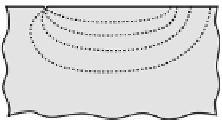Biomedical Engineering Reference
In-Depth Information
bilayer rupture by uncontrolled pore growth and the
outcome is governed by the local plasma membrane
potential,
D
j
PM
, behavior and the relative large mem-
brane tension (Esser et al., 2007).
IRE for tissue ablation
IRE has been studied extensively with in vitro cellular
systems. IRE has also been studied as method to destroy
prokaryotic (Sale and Hamilton, 1967) and eukaryotic
cells in vitro and has gain momentum recently as
a method to kill microorganisms (Vernhes et al., 1999),
mammalian normal cells (Vernhes et al., 1999) as well as
mammalian cancer cells (Miller et al., 2005) in vitro and
tumors (Nuccitelli et al., 2006). These studies have
demonstrated the ability of IRE, to completely eradicate
an entire population of cells in vitro without inducing any
thermal damage.
Lee et al. hypothesized that electrical injury is often
characterized by the preferential death of large mam-
malian cells (skeletal muscle, nerves) in tissue regions
where insignificant temperature rise occurs (Bhatt et al.,
1990; Lee et al., 2000; Esser et al., 2007). With the key
distinction between shock trauma and temperature
change, this research group opened the door to the ap-
plication of IRE as an alternate tissue ablation technique
(Lee and Despa, 2005).
Davalos, Mir and Rubinsky recently postulated that IRE
can be used as an independent drug-free tissue ablation
modality for particular use in cancer therapy (Davalos
et al., 2005). This minimally invasive procedure involves
placing electrodes into or around the targeted area to de-
liver a series of short and intense electric pulses that induce
the irreversible structural changes in the cell membrane
(Edd and Davalos, 2007). This induced potential is de-
pendentonavarietyofconditionssuchastissuetypeand
cell size (Edd and Davalos, 2007). Due to the changes in
the cell membrane resistance during electroporation the
technique can be controlled and monitored with EIT,
a real-time imaging method that maps the electrical im-
pedance distribution inside the tissue (Davalos et al.,
2004). Ivorra et al. concluded in (Ivorra and Rubinsky,
2007) that impedance measurements can be employed to
detect and distinguish reversible and IRE in in vivo and in
situ liver tissue. IRE produces a well-defined region of
tissue ablation, without areas in which the extent of
damage changes gradually as during thermal ablation
(Rubinsky, 2007). A single cell is either destroyed by IRE
or not (Rubinsky, 2007). The IRE pulses do not compro-
mise the blood vessel matrix and appears to be safe and
cause no complications as suggested in (Maor et al., 2007).
In addition, it has been shown through mathematical
modeling that the area ablated by irreversible tissue elec-
troporation prior to the onset of thermal effects is sub-
stantial and comparable to that of other tissue ablation
NB!
Figure 4.1-20 Monopolar electrosurgery and an implant, for
example a pacemaker with intracardial catheter electrode.
Importance of catheter direction with respect to current density
direction.
4.1.14 Cell suspensions
4.1.14.1 Electroporation
and electrofusion
Electroporation is the phenomenon in which cell
membrane permeability to ions and macromolecules is
increased by exposing the cell to short (microsecond to
millisecond) high voltage electric pulses (Weaver, 2003).
While the mechanism for electroporation is not yet
completely understood experiments show that the ap-
plication of electrical pulses can have different effects
on the cell membrane, as a function of various pulse
parameters; such as amplitude, duration, pulse shape
and repetition rate (Mir, 2001). As a function of these
parameters, the application of the electrical pulse can
have no effect, can have a transient effect known as
reversible electroporation or can cause permanent per-
meation known as irreversible electroporation (IRE)
which leads to non-thermal cell death by necrosis
(Weaver, 2003; Davalos et al., 2005). It is thought that
the induced potential across the cell membrane causes
instabilities in the polarized lipid bilayer (Weaver and
Barnett, 1992; Weaver and Chizmadzhev, 1996; Edd
et al., 2006). The unstable membrane then alters its
shape forming aqueous pathways that possibly are nano-
scale pores through the cell's plasma membrane
(Neumann and Rosenheck, 1972; Neumann et al., 1989;
Weaver, 1995). Irreversible behavior is attributed to



































